Quick Look
Grade Level: 4 (3-5)
Time Required: 1 hours 45 minutes
Note: Over two days.
Expendable Cost/Group: US $3.00
Group Size: 2
Activity Dependency: None
Subject Areas: Geometry, Physical Science, Problem Solving, Reasoning and Proof, Science and Technology
NGSS Performance Expectations:

| 3-PS2-1 |
Summary
Using common materials (spools, string, soap), students learn how a pulley can be used to easily change the direction of a force, making the moving of large objects easier. They see the difference between fixed and movable pulleys, and the mechanical advantage gained with multiple/combined pulleys. They also learn the many ways engineers use pulleys for everyday purposes.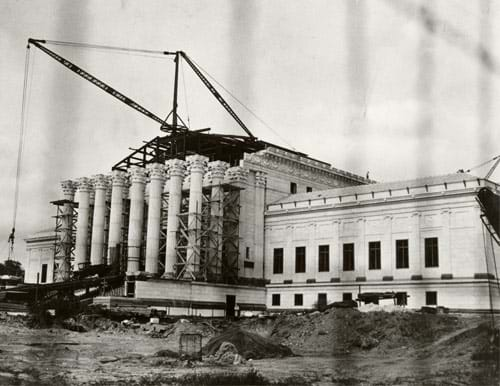
Engineering Connection
Thousands of years ago as well as today, engineers used pulleys to make everyday tasks and large construction projects easier. They use pulleys to raise heavy objects, taking advantage of gravity to help lift an object. Engineers incorporate pulleys into a wide range of modern-day applications, such as cranes for lifting very heavy objects in construction projects, elevators, flagpoles, motors, bicycles and boats. To gain a mechanical advantage using multiple pulleys in conjunction with motors and electronics, engineers create devices that operate with very little power for how much work they perform.
Learning Objectives
After this activity, students should be able to:
- Describe how pulleys make work easier for engineers.
- Demonstrate the difference between fixed and movable pulleys.
- Describe everyday examples of pulleys used by engineers.
Educational Standards
Each TeachEngineering lesson or activity is correlated to one or more K-12 science,
technology, engineering or math (STEM) educational standards.
All 100,000+ K-12 STEM standards covered in TeachEngineering are collected, maintained and packaged by the Achievement Standards Network (ASN),
a project of D2L (www.achievementstandards.org).
In the ASN, standards are hierarchically structured: first by source; e.g., by state; within source by type; e.g., science or mathematics;
within type by subtype, then by grade, etc.
Each TeachEngineering lesson or activity is correlated to one or more K-12 science, technology, engineering or math (STEM) educational standards.
All 100,000+ K-12 STEM standards covered in TeachEngineering are collected, maintained and packaged by the Achievement Standards Network (ASN), a project of D2L (www.achievementstandards.org).
In the ASN, standards are hierarchically structured: first by source; e.g., by state; within source by type; e.g., science or mathematics; within type by subtype, then by grade, etc.
NGSS: Next Generation Science Standards - Science
| NGSS Performance Expectation | ||
|---|---|---|
|
3-PS2-1. Plan and conduct an investigation to provide evidence of the effects of balanced and unbalanced forces on the motion of an object. (Grade 3) Do you agree with this alignment? |
||
| Click to view other curriculum aligned to this Performance Expectation | ||
| This activity focuses on the following Three Dimensional Learning aspects of NGSS: | ||
| Science & Engineering Practices | Disciplinary Core Ideas | Crosscutting Concepts |
| Plan and conduct an investigation collaboratively to produce data to serve as the basis for evidence, using fair tests in which variables are controlled and the number of trials considered. Alignment agreement: Science investigations use a variety of methods, tools, and techniques.Alignment agreement: | Each force acts on one particular object and has both strength and a direction. An object at rest typically has multiple forces acting on it, but they add to give zero net force on the object. Forces that do not sum to zero can cause changes in the object's speed or direction of motion. (Boundary: Qualitative and conceptual, but not quantitative addition of forces are used at this level.) Alignment agreement: Objects in contact exert forces on each other.Alignment agreement: | Cause and effect relationships are routinely identified. Alignment agreement: |
Common Core State Standards - Math
-
Use appropriate tools strategically.
(Grades
K -
12)
More Details
Do you agree with this alignment?
-
Multiply or divide to solve word problems involving multiplicative comparison, e.g., by using drawings and equations with a symbol for the unknown number to represent the problem, distinguishing multiplicative comparison from additive comparison.
(Grade
4)
More Details
Do you agree with this alignment?
-
Add, subtract, multiply, and divide decimals to hundredths, using concrete models or drawings and strategies based on place value, properties of operations, and/or the relationship between addition and subtraction; relate the strategy to a written method and explain the reasoning used.
(Grade
5)
More Details
Do you agree with this alignment?
International Technology and Engineering Educators Association - Technology
-
Design solutions by safely using tools, materials, and skills.
(Grades
3 -
5)
More Details
Do you agree with this alignment?
State Standards
Colorado - Math
-
Appropriate measurement tools, units, and systems are used to measure different attributes of objects and time.
(Grade
4)
More Details
Do you agree with this alignment?
-
Multiply or divide to solve word problems involving multiplicative comparison.
(Grade
4)
More Details
Do you agree with this alignment?
-
Add, subtract, multiply, and divide decimals to hundredths.
(Grade
5)
More Details
Do you agree with this alignment?
Materials List
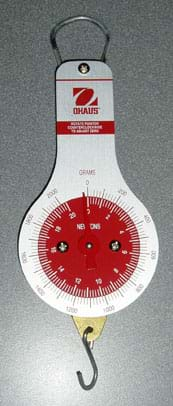
Each group needs:
- 2 small pulleys (purchase from a hardware store, or use a thread spool with a chopstick, straw, pencil, dowel, toothpick or wooden cooking skewers that fits through the spool hole as an axle, allowing the spool to rotate freely around it)
- 1 meter of string (strong enough to support the object being raised)
- A weight to be raised by the pulley (for example, a bar of soap or a plastic milk/juice jug with water or sand inside; the object should weigh ¾ of the maximum weight that can be measured by the spring scale)
- Pulley'ing Your Own Weight Worksheet
For the entire class to share:
- Masking tape
- Spring scale (one per team if available, or a few to share with the class; available from science supply catalogs, stores or websites)
- String (if using spools for pulleys, cut extra pieces, as needed, to tie axle to weight)
Worksheets and Attachments
Visit [www.teachengineering.org/activities/view/cub_simple_lesson05_activity1] to print or download.Pre-Req Knowledge
General knowledge of pyramids. Familiarity with the six simple machines introduced in Lesson 1 of this unit.
Introduction/Motivation
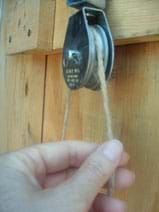
Imagine that the whole class is on the roof of a tall building, looking down at the street below. On the street are the parts for a roller coaster that we want to install on the top of the building. Our problem is that the pieces do not fit into the elevator and the building is much too high for us to simply lift it up to the roof. How can we possibly get these roller coaster parts, which weigh about 1,000 kilograms each, to the roof in one piece? Are there any simple machines that would help? We could use inclined planes and go back and forth up the side of the building but that would be dangerous and it would take too much time.
The best answer is to use pulleys! A pulley is a wheel and axle with a rope over it. A pulley is one type of simple machine. Pulleys enable us to get big items up to the roof without any trouble at all. But, what route do we take using the pulleys? We have so many options...
- What if we tie a rope to the roller coaster part and then put the rope over a pulley placed on the edge of the roof? The free end of the rope can be pulled by all the students on the roof (like a tug of war) to bring the part up to the roof. It would take a lot of effort, but we could do it (assuming we do not fall off the other side of the building first!).
- Hmmm... Falling off the other side of the building might not be so bad after all... or at least having the rope fall off the other side of the building. If we used another pulley on the other side of the building and a longer rope we could pull down on the rope from the ground on the other side of the building. Pulling down would be easier than pulling up.
- Both of those options require that we use 1,000 kilograms of force to raise the part. If we attach a 500-kilogram weight to our side of the rope and then pull, we would only have to pull with 500 kilograms of force. In this case, we would be using gravity to our advantage and making our work easier.
All of these options are examples of fixed pulleys. There is also a movable pulley option. Attaching the pulley to the roller coaster part, one side of the rope to the top of the building and us pulling on the other side of the rope would enable us to do the same thing as the first two options. We could also create a mechanical advantage by using a fixed pulley and a movable pulley together, as a pulley system. It would take twice as much rope, but only half as much strength.
Engineers think of ways to do tasks — such as lifting heavy objects or even lifting light objects high above our heads — everyday. We see examples all around us, for example, a crane that uses several pulleys lifts heavy objects (see Figure 1) on a construction site. Something as simple as the flagpole outside the school uses a pulley to raise a light object, the flag, high above our heads. Do you see how valuable it can be to use a pulley to redirect the direction of a force?
Pulleys are not always used for lifting objects. Sometimes the purpose of a pulley is to move object or provide a continuous line. A bicycle chain uses two pulleys and a chain that continues to go around in circles.
Engineers make complex machines by combining together several simple machines, so that many difficult tasks may be done more easily. For example, using a large screw at one end of the rope and turning the screw like a crank would enable even easier rising of the roller coaster parts.
Today, we are going to look more at fixed pulleys, movable pulleys and pulley systems. Then, we can use what we learn to think about how we could use pulleys to engineer an ancient pyramid.
(optional) To set the stage for this activity, show students the attached Wheeling It In! PowerPoint presentation. Show the PowerPoint presentation, or print out the slides to use with an overhead projector. The presentation is animated to promote an inquiry-based style; each click reveals a new point about each machine; have students suggest characteristics and examples before you reveal them.
(optional) Print out the attached Pulley Visual Aids (on paper or overhead transparencies) to review fixed and movable pulleys, and pulley systems with the students.
Procedure
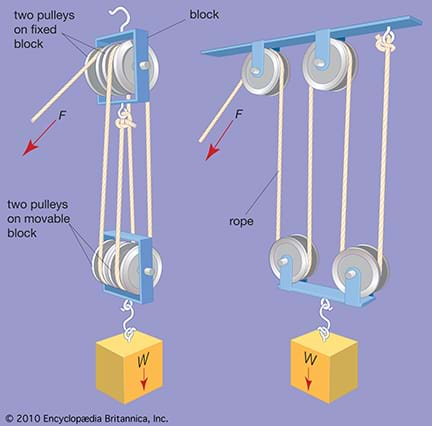
Before the Activity
- Gather materials and make copies of the Pulley'ing Your Own Weight Worksheet.
- Cut 1 meter of string for each group.
- Set up to use the Pulleys and the Pyramids PowerPoint presentation (optional).
With the Students
- Divide the class into teams of two students each.
- Distribute all materials to the teams (2 pulleys, string, worksheet and 1 object to lift for each group). Make available tape and a spring scale, either for each team or to share among the teams.
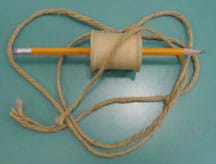
- Tie one end of the string to the object to lift.
- Tie a small loop in the other end of the string.
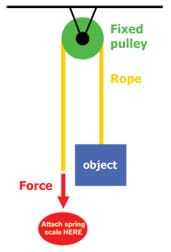
Figure 4. Fixed pulley. - Weigh the object by hooking the loop of string to the hook on the spring scale and pulling the object straight up in the air. Record this value on the worksheet.
- Create a fixed pulley by running the string over the pulley wheel.
- If using spools, have students create a pulley by placing a pencil, chopstick or straw through the middle of the spool as an axle (see Figure 3). Make sure the spool is able to freely rotate around the axle.
- Have one student hold the pulley still and another pull the string sideways or down, as shown in Figure 4. Record the force needed (measurement on the spring scale) on the worksheet.
- Next, create a movable pulley by attaching the pulley to the object (see Figure 5). If using pre-fabricated pulleys, attach with tape. If using spools, attach the pulley axle to the object with tape or string, making sure the spool still rotates freely.)
- One student holds the string in place while another student lifts the object by pulling up on the spring scale string, as shown in Figure 5.
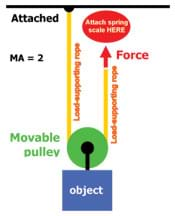
- Observe how much force is required to lift the object (spring scale measurement) and record it on your worksheet.
- Last, create a pulley system. Run the string through one pulley (the fixed pulley) and through the other (the movable pulley, which has the object attached to it), as in Figure 6.
- Have one student hold the free end of the rope and the fixed pulley, while another student raises the object by pulling down on the spring scale. Record on the worksheet the force required to lift the object (spring scale measurement) with this two-pulley system.
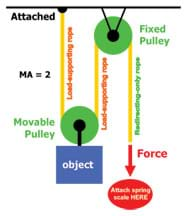
- Provide time for the student teams to complete the remainder of the worksheet.
- Conclude by comparing results as a class, and discussing the mechanical advantages seen by using the various pulley configurations.
Vocabulary/Definitions
block and tackle: An apparatus of pulleys and ropes used for hauling and hoisting heavy objects (see Figure 2).
fixed pulley: A pulley system with the pulley attached to a fixed point and the rope attached to the object. A single fixed pulley gives no increase of power, but serves simply to change the direction of motion.
force: A push or a pull on an object; the capacity to do work.
mechanical advantage : An advantage gained by using simple machines to accomplish work with less effort. Making the task easier (which means it requires less force), but may require more time or room to work (more distance, rope, etc.). For example, applying a smaller force over a longer distance to achieve the same effect as applying a large force over a small distance. The ratio of the output force exerted by a machine to the input force applied to it.
movable pulley: A pulley system with the pulley attached to the object itself, and one side of the rope attached to a fixed point.
pulley: A simple machine that changes the direction of a force, often to lift a load. Usually consists of a grooved wheel in which a pulled rope or chain runs.
redirect force: To change the direction of a push or pull to gain mechanical advantage over a task.
simple machine: A machine with few or no moving parts that is used to make work easier (provides a mechanical advantage). For example, a wedge, wheel and axle, lever, inclined plane, screw, or pulley.
work: Force on an object multiplied by the distance it moves. W = F x d (force multiplied by distance).
Assessment
Pre-Activity Assessment
Discussion Questions: Solicit, integrate and summarize student responses.
- Who knows what a pulley is? (Possible answers: A wheel and axle with a rope over it. A type of simple machine.)
- Where have you seen pulleys before? (Possible answers: Crane, flagpole, blinds or shades, gym equipment, clothesline, water well, zip line, bike chain, elevator, boats.)
- Why do people use pulleys? (Possible answers: To change the direction of force or make it easier to lift something. To raise something high above our heads. To move something. To make things move easier.)
Activity Embedded Assessment
Worksheet: Have students record their test results on the activity worksheet; review their answers to gauge their mastery of the subject. Look at the drawn diagrams. Did they draw them correctly? Do students understand the differences between a fixed pulley, movable pulley and a pulley system? Is the class noticing that multiple pulleys are making it easier? If the students need more clarification of the mechanical advantage gained by multiple pulleys, conduct the demonstration described in the Activity Extension section.
Post-Activity Assessment
Engineering Design: Have students first brainstorm and then design and draw a fixed pulley, movable pulley or pulley system, to move a large object. Give them a scenario, for example, to move large stone blocks to the top of a pyramid, or move a satellite dish, hot tub or antenna to the top of a skyscraper). Have them draw the object to be moved (pyramid blocks) and illustrate the pulley system in action. Have them label two forces on their drawing — weight and direction of applied force. Have students share their ideas with the class and explain why they chose specific pulley types for their design.
Troubleshooting Tips
Depending on resources, stations could be established with different pulley systems for the students to rotate through. Or, set up example pulley systems and have students re-create their own systems.
If straws bend due to the weight of the object (some objects may be too heavy for straws), use chopsticks, pencils or toothpicks.
The spool should spin freely on its axle. If the pulley does not rotate freely, the axle may be too large; try a thinner item for an axle, such as toothpicks or wooden cooking skewers.
If not enough pulleys are available, have two teams pair up to make the pulley system (steps 12 and 13.)
If the force recorded for the two-pulley system measures larger than the other forces recorded, it is likely because there is too much friction in the spools. Re-arrange the spools so they move freely around the axle and try again. This could also lead to a class discussion on friction and how engineers must design pulleys to have as little friction as possible. Use pre-fabricated metal or plastic pulleys to demonstrate the reduced friction compared to thread spool pulleys.
Activity Extensions
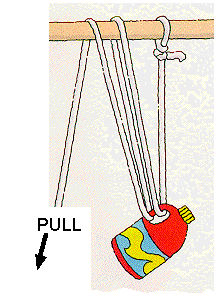
The class may benefit from a demonstration using heavier objects than those used in the activity, so that they really notice that the amount of force required drops when using multiple pulleys. Use a plastic milk or juice jug filled with sand or liquid. Tie a rope to a strong bar (or rod) above your head (a swing set works well). Run the rope through the handle of the jug and then over the bar overhead. Raise the jug by pulling the rope down; let students feel how difficult it is to do this. Next, run the rope through the jug and over the bar again. Raise the jug again. Continue to loop the rope through the jug and over the bar noting how much easier it becomes to raise the jug (see Figure 7); this is a good example of how a block and tackle (see Figure 2) works. (Source: https://www.grc.nasa.gov/WWW/K-12/Summer_Training/KaeAvenueES/pulleys.html)
Math Extension: With the class, have the students calculate the force required to lift their bodyweight using a two-pulley system based on the results from the Pulley'ing Your Own Weight Worksheet. Example: A student weighs 65 lbs and they find that it only takes 5 N of force to lift a 10 N object using their two-pulley system. The force required to lift the student can be calculated as: 5 N / 10 N x 65 lbs = 32 ½ lbs.
Activity Scaling
- For upper grades, test more pulleys and measure for force needed to move the object. You may want to introduce some trigonometry by looking at the angles at which the object is pulled up.
- For lower grades, eliminate some of the math calculations by just having the students complete the measurements and chart them.
Subscribe
Get the inside scoop on all things TeachEngineering such as new site features, curriculum updates, video releases, and more by signing up for our newsletter!More Curriculum Like This

Students learn how a pulley can be used to change the direction of applied forces and move/lift extremely heavy objects, and the powerful mechanical advantages of using a multiple-pulley system. Students perform a simple demonstration to see the mechanical advantage of using a pulley, and they ident...

Students are introduced to three of the six simple machines used by many engineers: lever, pulley, and wheel-and-axle. In general, engineers use the lever to magnify the force applied to an object, the pulley to lift heavy loads over a vertical path, and the wheel-and-axle to magnify the torque appl...

Students are introduced to the six types of simple machines — the wedge, wheel and axle, lever, inclined plane, screw, and pulley — in the context of the construction of a pyramid, gaining high-level insights into tools that have been used since ancient times and are still in use today.

Students apply the mechanical advantages and problem-solving capabilities of six types of simple machines (wedge, wheel and axle, lever, inclined plane, screw, pulley) as they discuss modern structures in the spirit of the engineers and builders of the great pyramids.
References
Dictionary.com. Lexico Publishing Group, LLC. Accessed February 1, 2006. (Source of some vocabulary definitions, with some adaptation) http://www.dictionary.com
Handtools for Trail Work, Tools for Lifting and Hauling, Block and Tackles. Updated February 1, 2006. Environment, Federal Highway Administration, U.S. Department of Transportation. Accessed February 1, 2006. (Source of block and tackle image.) http://www.fhwa.dot.gov/environment/fspubs/05232810/page16.htm
Huddle, Carol. Pulleys. Simple Machines Lesson Plans, Glenn Learning Technologies Project, Glenn Research Center, NASA. Accessed February 1, 2006. (Source of Activity Extension.) https://www.grc.nasa.gov/WWW/K-12/Summer_Training/KaeAvenueES/pulleys.html
Tensile Strength Test Strand. Space Team Online, NASA Quest. Accessed February 1, 2006. http://quest.arc.nasa.gov/space/teachers/suited/9c1ten.html
Copyright
© 2005 by Regents of the University of Colorado.Contributors
Justin Fritts; Lawrence E. Carlson; Jacquelyn Sullivan; Malinda Schaefer Zarske; Denise Carlson, with design input from the students in the spring 2005 K-12 Engineering Outreach Corps course.Supporting Program
Integrated Teaching and Learning Program,, College of Engineering, University of Colorado BoulderAcknowledgements
The contents of this digital library curriculum were developed under a grant from the Fund for the Improvement of Postsecondary Education (FIPSE), U.S. Department of Education, and National Science Foundation GK-12 grant no 0338326. However, these contents do not necessarily represent the policies of the Department of Education or National Science Foundation, and you should not assume endorsement by the federal government.
Last modified: October 31, 2021









User Comments & Tips